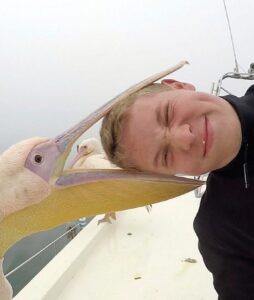The Haast’s eagle (Hieraaetus moorei), a colossal bird of prey, once ruled the skies of New Zealand. Renowned for its formidable size, unmatched hunting prowess, and ecological significance, this apex predator left an indelible mark on the history of avian evolution. Yet, despite its dominance, the Haast’s eagle disappeared around 500 years ago, a victim of ecological upheaval largely driven by human activity.
 Pin
Pin Image by Maz Dave from Pinterest
Table of Contents
The Apex Predator of Ancient New Zealand
Haast’s eagle was a predator unlike any seen in the skies today. Native to the South Island of New Zealand, this bird was the largest eagle known to have existed. Females, which were larger than males, could weigh up to 15 kilograms (33 pounds), with a wingspan approaching 3 meters (10 feet). While its wingspan was not as wide as some modern eagles, its structure was specialized for maneuverability in dense forests.
This bird’s body was heavily built, with powerful legs and talons capable of exerting immense pressure—enough to crush the bones of its prey. Its skull and beak were equally impressive, designed for piercing and tearing flesh. These features made the Haast’s eagle an apex predator, preying primarily on the moa, a group of large, flightless birds native to New Zealand.
The Haast’s Eagle and Moa: A Predator-Prey Dynamic
 Pin
Pin Image from Pinterest
The moa, which comprised several species, ranged in size from small bush moa to giant moa that stood over 3.6 meters (12 feet) tall and weighed up to 250 kilograms (550 pounds). Despite their size, moas were herbivores with no natural defenses against predators like the Haast’s eagle.
The eagle’s hunting strategy was highly specialized. Its powerful wings allowed it to navigate the dense forests of New Zealand with precision, while its sharp eyesight helped it detect prey from significant distances. Once a moa was located, the eagle would launch a high-speed dive, reaching velocities of up to 80 kilometers per hour (50 mph). With its massive talons, it would strike the moa’s back or head, delivering a fatal blow that immobilized the bird almost instantly.
This predator-prey relationship formed the cornerstone of New Zealand’s terrestrial ecosystem for thousands of years. The moa provided the Haast’s eagle with a reliable food source, while the eagle’s predation helped regulate moa populations.
Evolutionary Origins: From Small Beginnings to a Giant
Genetic studies have revealed that the Haast’s eagle evolved from a much smaller ancestor, the little eagle (Hieraaetus morphnoides), which still exists in Australia today. This transformation occurred over a relatively short evolutionary period of 1–2 million years, driven by the phenomenon of island gigantism.
Island gigantism occurs when animals evolve larger sizes due to the absence of competitors or predators, and the Haast’s eagle is a prime example. With no mammalian predators or other large birds of prey in New Zealand, the eagle grew to dominate its ecological niche. This rapid evolution highlights the adaptability of species in isolated environments, but it also underscores their vulnerability to sudden changes.
The Arrival of Humans: A Tipping Point for Extinction
The Haast’s eagle thrived for millennia, but its survival depended on the continued presence of the moa. This delicate balance was disrupted approximately 750 years ago when Polynesians, the ancestors of the Māori, settled in New Zealand.
The arrival of humans marked a turning point for the moa population. Moas were a vital resource for the Māori, providing meat, feathers, and bones for tools and ornaments. Human hunting, combined with habitat destruction through forest clearing, led to the rapid decline and eventual extinction of all moa species within a few centuries.
As the moa population collapsed, the Haast’s eagle lost its primary food source. While it may have attempted to adapt by hunting smaller animals, the eagle’s size and hunting strategy were ill-suited for this shift. Unable to find sufficient food, the Haast’s eagle succumbed to starvation and eventually disappeared.
 Pin
Pin Image from Pinterest
A Legacy Preserved in Fossils and Myth
Although extinct, the Haast’s eagle has not been forgotten. Its remains, preserved in fossils discovered across New Zealand, have provided valuable insights into its anatomy and behavior. These fossils reveal a bird with robust bones, enormous talons, and adaptations that made it one of the most efficient predators of its time.
The Māori also preserved the eagle’s memory through oral traditions. Known as the “Pouakai” or “Hokioi”, the Haast’s eagle was described as a giant bird of prey capable of attacking humans. While these accounts are likely embellished, they reflect the awe and fear inspired by this formidable predator.
The Ecological Consequences of Extinction
The extinction of the Haast’s eagle highlights the cascading effects of losing a keystone species. Keystone species, such as apex predators, play a critical role in maintaining the structure and stability of ecosystems.
The disappearance of the Haast’s eagle and the moa triggered significant ecological changes in New Zealand. Without the moa to graze on vegetation, plant communities underwent shifts, altering the composition of forests and grasslands. Similarly, the loss of the Haast’s eagle removed an apex predator, leaving a void in the island’s food web.
These changes serve as a stark reminder of the interconnectedness of ecosystems and the unintended consequences of human actions.
Modern Science and the Haast’s Eagle
Advances in paleontology and genetic research have deepened our understanding of the Haast’s eagle. Modern technology has allowed scientists to reconstruct its anatomy, flight mechanics, and hunting behavior with remarkable detail.
In 2005, researchers successfully sequenced DNA from Haast’s eagle fossils, confirming its evolutionary lineage and shedding light on its rapid adaptation to New Zealand’s unique environment. These findings have not only enhanced our knowledge of the species but also provided a window into the dynamics of island ecosystems.
A Broader Call to Action
The extinction of the Haast’s eagle is not merely a historical footnote; it is a stark representation of what is at stake as human activity continues to strain Earth’s ecosystems. In the modern era, the pressures that led to the demise of species like the Haast’s eagle and the moa have multiplied exponentially. Habitat destruction, overhunting, pollution, invasive species, and climate change create an environment where extinction events occur at a rate unmatched since the time of the dinosaurs.
Understanding the lessons from the Haast’s eagle’s extinction requires a multi-faceted approach: it is not enough to lament the loss. Active intervention, systemic changes, and global cooperation are necessary to protect the natural world. The eagle’s story is a reminder that even the mightiest and most well-adapted species are not immune to extinction when the balance of nature is disrupted.
The Fragility of Island Ecosystems
Islands like New Zealand are particularly vulnerable to biodiversity loss. Their ecosystems often evolve in isolation, creating unique species that lack defenses against new predators, competitors, or diseases introduced by humans. The Haast’s eagle and moa are prime examples of how the introduction of humans, along with their associated activities, can unravel the delicate threads of an island ecosystem.
Modern parallels can be drawn from similar situations, such as the decimation of bird populations in Hawaii due to introduced species like rats, cats, and mongoose. Learning from these examples requires implementing stringent biosecurity measures, fostering habitat restoration efforts, and protecting endemic species from human-driven threats.
The Ripple Effect of Extinction
The Haast’s eagle’s extinction illustrates a principle that ecologists call the “trophic cascade.” When a keystone species, such as an apex predator, is removed, it causes a chain reaction that disrupts the entire ecosystem. The loss of the moa altered vegetation patterns in New Zealand, which in turn affected other species dependent on the same habitats. The extinction of the Haast’s eagle eliminated a top predator, leaving an ecological gap that no other species could fill.
In the global context, this ripple effect can be seen in many regions. For example, the decline of large predators such as wolves and big cats has led to overpopulation of herbivores in certain areas, causing widespread habitat degradation. Restoring balance often requires rewilding efforts, as seen in the reintroduction of wolves to Yellowstone National Park, which rejuvenated the ecosystem by controlling elk populations.
The Role of Conservation Science
- Habitat Protection and Restoration: Preserving and restoring natural habitats is vital for the survival of countless species. In the case of the Haast’s eagle, the loss of New Zealand’s forests exacerbated its decline. Today, similar efforts focus on reforestation projects, creating wildlife corridors, and protecting critical habitats from development.
- Species Monitoring and Protection: Advances in technology, such as satellite tracking, genetic studies, and AI-driven biodiversity monitoring, enable scientists to identify at-risk species and intervene before it’s too late. For island ecosystems, early detection and eradication of invasive species can prevent catastrophic losses.
- Community Involvement: Conservation cannot succeed without the active participation of local communities. Empowering indigenous groups, as seen with the Māori in New Zealand, ensures that traditional knowledge and cultural values are integrated into modern conservation efforts.
- Global Cooperation: Biodiversity loss is a global issue that requires international collaboration. Treaties like the Convention on Biological Diversity and initiatives like the United Nations’ Decade on Ecosystem Restoration aim to mobilize resources and unite nations in a common goal.
The Ethical Dimension of Extinction
The extinction of the Haast’s eagle also raises important ethical questions. As the dominant species on Earth, humans have a responsibility to steward the planet’s biodiversity. Extinction is a natural process, but the rate at which species are disappearing today is largely a result of human activity.
This prompts a critical question: what does humanity owe to the species it has displaced? Some argue for the concept of “rewilding” or even using technologies like de-extinction to restore lost species. However, bringing back a species like the Haast’s eagle would require reconstructing its entire ecosystem, including the moa and its forested habitat—an undertaking that may not be feasible.
The ethical challenge is not merely about what we can do with new technologies but also about prioritizing efforts to prevent further losses of species currently on the brink.
Hope for the Future: Success Stories
Although the Haast’s eagle is gone, there are many examples of species that have been brought back from the brink of extinction, offering hope for future conservation efforts. For example:
- The Bald Eagle: Once endangered due to pesticide use, habitat loss, and hunting, the bald eagle in the United States rebounded after legal protections, conservation programs, and public awareness campaigns.
- The Kakapo: Another New Zealand bird, the flightless kakapo, was critically endangered but has seen population growth thanks to intensive conservation efforts involving predator control and captive breeding.





























